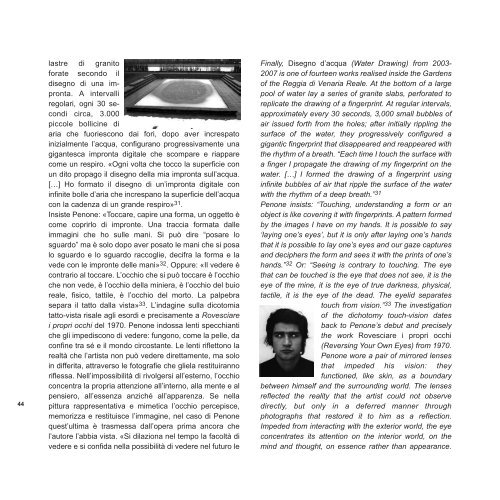Adachiara Zevi - arteinmemoria
Adachiara Zevi - arteinmemoria
Adachiara Zevi - arteinmemoria
Create successful ePaper yourself
Turn your PDF publications into a flip-book with our unique Google optimized e-Paper software.
44<br />
lastre di granito<br />
forate secondo il<br />
disegno di una impronta.<br />
A intervalli<br />
regolari, ogni 30 secondi<br />
circa, 3.000<br />
piccole bollicine di<br />
aria che fuoriescono dai fori, dopo aver increspato<br />
inizialmente l’acqua, configurano progressivamente una<br />
gigantesca impronta digitale che scompare e riappare<br />
come un respiro. «Ogni volta che tocco la superficie con<br />
un dito propago il disegno della mia impronta sull’acqua.<br />
[…] Ho formato il disegno di un’impronta digitale con<br />
infinite bolle d’aria che increspano la superficie dell’acqua<br />
con la cadenza di un grande respiro» 31 .<br />
Insiste Penone: «Toccare, capire una forma, un oggetto è<br />
come coprirlo di impronte. Una traccia formata dalle<br />
immagini che ho sulle mani. Si può dire “posare lo<br />
sguardo” ma è solo dopo aver posato le mani che si posa<br />
lo sguardo e lo sguardo raccoglie, decifra la forma e la<br />
vede con le impronte delle mani» 32 . Oppure: «Il vedere è<br />
contrario al toccare. L’occhio che si può toccare è l’occhio<br />
che non vede, è l’occhio della miniera, è l’occhio del buio<br />
reale, fisico, tattile, è l’occhio del morto. La palpebra<br />
separa il tatto dalla vista» 33 . L’indagine sulla dicotomia<br />
tatto-vista risale agli esordi e precisamente a Rovesciare<br />
i propri occhi del 1970. Penone indossa lenti specchianti<br />
che gli impediscono di vedere: fungono, come la pelle, da<br />
confine tra sé e il mondo circostante. Le lenti riflettono la<br />
realtà che l’artista non può vedere direttamente, ma solo<br />
in differita, attraverso le fotografie che gliela restituiranno<br />
riflessa. Nell’impossibilità di rivolgersi all’esterno, l’occhio<br />
concentra la propria attenzione all’interno, alla mente e al<br />
pensiero, all’essenza anziché all’apparenza. Se nella<br />
pittura rappresentativa e mimetica l’occhio percepisce,<br />
memorizza e restituisce l’immagine, nel caso di Penone<br />
quest’ultima è trasmessa dall’opera prima ancora che<br />
l’autore l’abbia vista. «Si dilaziona nel tempo la facoltà di<br />
vedere e si confida nella possibilità di vedere nel futuro le<br />
Finally, Disegno d’acqua (Water Drawing) from 2003-<br />
2007 is one of fourteen works realised inside the Gardens<br />
of the Reggia di Venaria Reale. At the bottom of a large<br />
pool of water lay a series of granite slabs, perforated to<br />
replicate the drawing of a fingerprint. At regular intervals,<br />
approximately every 30 seconds, 3,000 small bubbles of<br />
air issued forth from the holes; after initially rippling the<br />
surface of the water, they progressively configured a<br />
gigantic fingerprint that disappeared and reappeared with<br />
the rhythm of a breath. “Each time I touch the surface with<br />
a finger I propagate the drawing of my fingerprint on the<br />
water. […] I formed the drawing of a fingerprint using<br />
infinite bubbles of air that ripple the surface of the water<br />
with the rhythm of a deep breath.” 31<br />
Penone insists: “Touching, understanding a form or an<br />
object is like covering it with fingerprints. A pattern formed<br />
by the images I have on my hands. It is possible to say<br />
‘laying one’s eyes’, but it is only after laying one’s hands<br />
that it is possible to lay one’s eyes and our gaze captures<br />
and deciphers the form and sees it with the prints of one’s<br />
hands.” 32 Or: “Seeing is contrary to touching. The eye<br />
that can be touched is the eye that does not see, it is the<br />
eye of the mine, it is the eye of true darkness, physical,<br />
tactile, it is the eye of the dead. The eyelid separates<br />
touch from vision.” 33 The investigation<br />
of the dichotomy touch-vision dates<br />
back to Penone’s debut and precisely<br />
the work Rovesciare i propri occhi<br />
(Reversing Your Own Eyes) from 1970.<br />
Penone wore a pair of mirrored lenses<br />
that impeded his vision: they<br />
functioned, like skin, as a boundary<br />
between himself and the surrounding world. The lenses<br />
reflected the reality that the artist could not observe<br />
directly, but only in a deferred manner through<br />
photographs that restored it to him as a reflection.<br />
Impeded from interacting with the exterior world, the eye<br />
concentrates its attention on the interior world, on the<br />
mind and thought, on essence rather than appearance.


